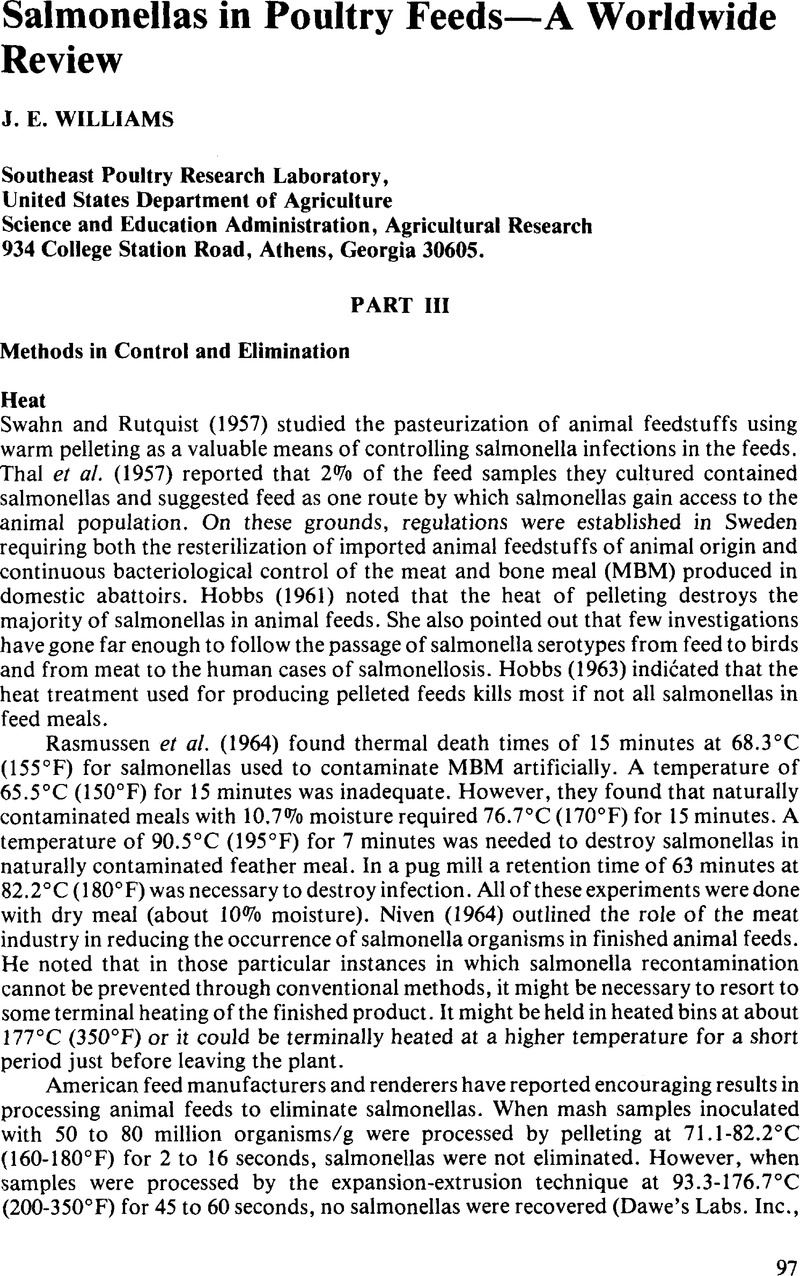Crossref Citations
This article has been cited by the following publications. This list is generated based on data provided by Crossref.
COX, N.A.
BAILEY, J.S.
and
THOMSON, J.E.
1982.
Evaluation of Procedures to Disperse Inoculated Salmonella in Poultry Feeds.
Poultry Science,
Vol. 61,
Issue. 2,
p.
382.
Impey, C. S.
Mead, G. C.
and
Hinton, M.
1987.
Influence of continuous challenge via the feed on competitive exclusion of salmonellas from broiler chicks.
Journal of Applied Bacteriology,
Vol. 63,
Issue. 2,
p.
139.
Humphrey, T. J.
Mead, G. C.
and
Rowe, B.
1988.
Poultry meat as a source of human salmonellosis in England and Wales.
Epidemiology and Infection,
Vol. 100,
Issue. 2,
p.
175.
IMPEY, C. S.
and
MEAD, G. C.
1989.
Fate of salmonellas in the alimentary tract of chicks pre‐treated with a mature caecal microflora to increase colonization resistance.
Journal of Applied Bacteriology,
Vol. 66,
Issue. 6,
p.
469.
IMPEY, C. S.
and
MEAD, G. C.
1989.
Fate of salmonellas in the alimentary tract of chicks pre‐treated with a mature caecal microflora to increase colonization resistance.
Journal of Applied Bacteriology,
Vol. 67,
Issue. 6,
p.
469.
COX, N.A.
BAILEY, J.S.
BLANKENSHIP, L.C.
MEINERSMANN, R.J.
STERN, N.J.
and
McHAN, F.
1990.
Research Note: Fifty Percent Colonization Dose for Salmonella typhimurium Administered Orally and Intracloacally to Young Broiler Chicks.
Poultry Science,
Vol. 69,
Issue. 10,
p.
1809.
HINTON, M.
and
MEAD, G.C.
1990.
Recent Advances in Animal Nutrition.
p.
31.
Hinton, M.
1993.
Spoilage and pathogenic microorganisms in animal feed.
International Biodeterioration & Biodegradation,
Vol. 32,
Issue. 1-3,
p.
67.
Leeson, S.
and
Marcotte, M.
1993.
Irradiation of poultry feed I. Microbial status and bird response.
World's Poultry Science Journal,
Vol. 49,
Issue. 1,
p.
19.
Iba, Ana Maria
and
Berchieri, A.
1995.
Studies on the use of a formic acid‐propionic acid mixture (Bio‐add™) to control experimentalSalmonellainfection in broiler chickens.
Avian Pathology,
Vol. 24,
Issue. 2,
p.
303.
BERCHIERI, A.
and
BARROW, P.A.
1996.
Reduction in Incidence of Experimental Fowl Typhoid by Incorporation of a Commercial Formic Acid Preparation (Bio-Add™) into Poultry Feed.
Poultry Science,
Vol. 75,
Issue. 3,
p.
339.
HA, S.D.
MACIOROWSKI, K.G.
KWON, Y.M.
and
RICKE, S.C.
1997.
INDIGENOUS POULTRY FEED MICROFLORA RESPONSE TO ETHYL ALCOHOL AND BUFFERED PROPIONIC ACID ADDITION.
Journal of Rapid Methods & Automation in Microbiology,
Vol. 5,
Issue. 4,
p.
309.
HA, S.D.
MACIOROWSKI, K.G.
and
RICKE, S.C.
1997.
ETHYL ALCOHOL REDUCTION OF SALMONELLA TYPHIMURIUM IN POULTRY FEED.
Journal of Rapid Methods & Automation in Microbiology,
Vol. 5,
Issue. 1,
p.
75.
HA, S.D.
JONES, F.T.
KWON, Y.M.
and
RICKE, S.C.
1997.
SURVIVAL OF AN UNIRRADIATED SALMONELLA TYPHIMURIUM MARKER STRAIN INOCULATED IN POULTRY FEEDS AFTER IRRADIATION.
Journal of Rapid Methods & Automation in Microbiology,
Vol. 5,
Issue. 1,
p.
47.
MACIOROWSKI, K.G.
PEÑA, J.
PILLAI, S.D.
and
RICKE, S.C.
1998.
APPLICATION OF GENE AMPLIFICATION IN CONJUNCTION WITH A HYBRIDIZATION SENSOR FOR RAPID DETECTION OF SALMONELLA SPP. AND FECAL CONTAMINATION INDICATORS IN ANIMAL FEEDS.
Journal of Rapid Methods & Automation in Microbiology,
Vol. 6,
Issue. 3,
p.
225.
Ha, S.D
Maciorowski, K.G
Kwon, Y.M
Jones, F.T
and
Ricke, S.C
1998.
Indigenous feed microflora and Salmonella typhimurium marker strain survival in poultry mash diets containing varying levels of protein.
Animal Feed Science and Technology,
Vol. 76,
Issue. 1-2,
p.
23.
Ha, S.D
Maciorowski, K.G
Kwon, Y.M
Jones, F.T
and
Ricke, S.C
1998.
Survivability of indigenous microflora and a Salmonella typhimurium marker strain in poultry mash treated with buffered propionic acid.
Animal Feed Science and Technology,
Vol. 75,
Issue. 2,
p.
145.
Kwon, Y.M
and
Ricke, S.C
1999.
Salmonella typhimurium poultry isolate growth response to propionic acid and sodium propionate under aerobic and anaerobic conditions.
International Biodeterioration & Biodegradation,
Vol. 43,
Issue. 4,
p.
161.
Pillai, Suresh D
and
Ricke, Steven C
2002.
Review / SynthèseBioaerosols from municipal and animal wastes: background and contemporary issues.
Canadian Journal of Microbiology,
Vol. 48,
Issue. 8,
p.
681.
WHYTE, PAUL
McGILL, KEVINA
and
COLLINS, JOHN DANIEL
2003.
A SURVEY OF THE PREVALENCE OF SALMONELLA AND OTHER ENTERIC PATHOGENS IN A COMMERCIAL POULTRY FEED MILL.
Journal of Food Safety,
Vol. 23,
Issue. 1,
p.
13.





